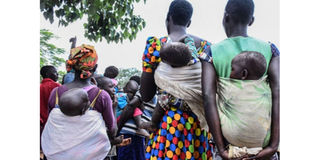
Statistics indicate that teenage mothers contribute 18 percent of the estimated 3,000 maternal deaths registered in the country annually. PHOTO FILE
Statistics from the Uganda Bureau of Statistics (UBOS) show that at least one in four Ugandan girls aged 15-19 has had a child or is pregnant, posing serious health, social and economic consequences to the youngsters and the country.
The teenage pregnancy rate has stagnated at 24 percent. This number is close to double the global average rate of 13 percent. Health and policy experts say the government needs to embrace realistic and practical approaches to curb the vice and protect young girls.
Dr Henry Mwebesa, the director general of health services at the Ministry of Health, says teenage pregnancy is a serious public health concern.
“The risk factors for teenage pregnancy include poverty, school dropout, rape, and inadequate education and information about the risks of teenage pregnancy. And, of course, there is poor access to contraceptives but this is a very controversial matter. We will have some battles with religious leaders because clearly, they are not in support of giving contraceptives to teenagers,” he says.
In rebuttal, Sheikh Ali Waiswa, the deputy Mufti of Uganda and a member of the Inter-Religious Council of Uganda's executive board says the government should focus on married couples instead.
“Ideally, religious leaders advocate for abstinence from sex if one is not yet of age. Contraceptives will help a married couple manage the number of children they want to have. But, if contraceptives are given to people who are not yet married, that would be promoting promiscuity and fornication,” he says.
Practical solutions
Prof Rhoda Wanyenze, the dean of Makerere University School of Public Health, says it is about time the country embraced practical solutions to the teenage pregnancy problem.
Some adolescents are already sexually active, which means they need these sexual and reproductive health services. Some of them, who have the information, are already accessing contraceptives. However, there is still no clear policy directive on how teenagers should access contraceptive services.
“The lack of a policy puts teenagers and adolescents at risk of unintended pregnancy and related complications. We have a high percentage of unintended pregnancy at 45 percent, with 62 percent of these being adolescents. This is because we have a restrictive policy against adolescents and young people. We can provide them with the information, but there is no policy to offer family planning methods to those who are sexually active,” Dr Richard Mugahi, the commissioner for reproductive and infant health at the Ministry of Health, says.
When older teenagers become sexually active and do not use protection, the result is always pregnancy, which causes some to solicit for unsafe abortions leading to the death os many.
"Abortion could be the leading cause of death among older adolescents." Dr Mugahi says.
Complications
Dr Mwebesa says young girls, whose reproductive systems are not yet well developed, will most likely have complications during pregnancy and delivery.
“Obstetricians says teenagers have a high chance of developing hypertension in pregnancy compared to an adult mother. High blood pressure is the second major cause of death among mothers, and normally, if they do not deliver in hospitals, we lose these teenagers. They are also prone to vesicovaginal fistula,” he adds.
High blood pressure places the victim at the risk of heart disease, heart attack, and stroke. During pregnancy, there are three types of high blood pressure that can affect a woman. These include, gestational hypertension, preeclampsia, and chronic hypertension. The first two types usually start around the 20th week of pregnancy.
Vesicovaginal fistula is an abnormal opening between the bladder and the vagina that results in continuous and unremitting urinary incontinence, a health problem with significant psychological, social, economic effects.
Slow progress made
The 2016 Uganda Demographic and Health Survey (UDHS) put the teenage pregnancy rate at 25 percent, while the 2022 UDHS put the rate at 24 percent. This signals slow progress despite more funds being channeled by development partners such as the United Nations Population Fund to fight the vice.
“So, are we doing a good job? Certainly not. For five years, we have reduced the teenage pregnancy rate by only one percent. Of course, this is not good. On average, the country has a teenage pregnancy rate of 24 percent, yet there are some districts where the teenage pregnancy rate is as high as 31 percent,” Dr Mwebesa admits.
Dr Betty Kyadondo, the director of family health at the National Population Council, says there is a need to empower teenage girls and give them opportunity to go back to schools.
“We need to see girls growing up to be girls; not girls growing up to be mothers. If girls were not giving birth at very early age, probably Uganda’s maternal mortality rate would not be very high at 189 [per 100,000] live births. These girls would also be in school and contribute to the nation’s development,” she says.
Statistics from the Ministry of Health, indicate that teenage mothers contribute 18 percent of the estimated 3,000 maternal deaths registered in the country annually.
Is the government not doing enough?
A 2023 report by Trac FM, in collaboration with Uganda Women's Network (Uwonet), Reach a Hand Uganda and the Belgium government, argue that the government is not doing enough to curb teenage pregnancies. Trac FM is a Kampala-based organisation that collects real-time data through different radio stations on cultural, socio-economic and political trends from citizens’ perspectives to inform policies and programs.
In the study, conducted among 44,200 people across the country between 2022 and 2023, the researchers recommend free access to contraceptives and condoms for teenagers to curb around 1000 unwanted pregnancies happening daily among them.
“A large majority (63 percent) of respondents, indicated that the main reason for teenage pregnancy is young people practicing unsafe sex and accidentally getting pregnant,” the report reads.
According to the report, besides the major cause of teenage pregnancy above, other causes were forced sex through rape, defilement, and incest (14 percent), a boy and girl deciding to have a baby (13 percent), and planned pregnancy through child marriage (10 percent).
“These findings are in stark contrast with the Uganda government’s position described in the Uganda National Strategy to End Child Marriage and Teenage Pregnancy in Uganda. While the strategy acknowledges the negative consequences of teenage pregnancy, it only recognises teenage pregnancy as a consequence of child marriage, rape and defilement, and ignores the fact that teenagers are experimenting with unsafe sex, as well as the importance of contraceptives in addressing the issue of teenage pregnancies,” the report reads further.
However, Dr Jotham Musinguzi, the director general of the National Population Council, says the promotion of contraceptive use among adolescents is a matter of national development that cannot be ignored.
“The government had made tremendous steps in ensuring that young people are empowered with education and jobs. However, if young people are sexually active and do not use family planning, they will become pregnant. This means all the government’s efforts, the ability to continue with education, get skills and employment, to empower them will be interfered with,” he says.
According to statistics from the United Nations Population Fund, between 2020 and 2021, 32,000 teenagers got pregnant every month in Uganda. This was during the COVID-19-induced lockdowns that saw schools shut down for months. These figures ranked Uganda as 10th in the world in terms of teenage pregnancy rate.
The Trac FM survey asked respondents about ways Uganda can curb teenage pregnancy and the majority were not aligned to the plan of promoting contraceptives and condoms among teenagers. Forty-three percent of respondents say young people should be told to abstain, and 14 percent said people should avoid mentioning contraceptives, as it will lead to promiscuity. Only 16 percent recommend free access to condoms for young people, 13 percent recommended free access to contraceptives while 14 percent said the government should educate teenagers at school on contraceptives and family planning.
In their summary, the authors of the report argue the “skewed perspective” about the cause of teenage pregnancy and how to address it, has made policymakers focus on wrong strategies that have not yielded desired outcome.
“The government policy is strongly influenced by religious institutions that may resist acknowledging the importance of safe sex practices, as it conflicts with their doctrines and values,” the report reads.
Dr Mwebesa, however, says the government is serious about fighting teenage pregnancies and has a target to reduce the rate from 24 to 15 percent over the next five years. He acknowledges that to do this, though, the government’s strategies need to be revived.



